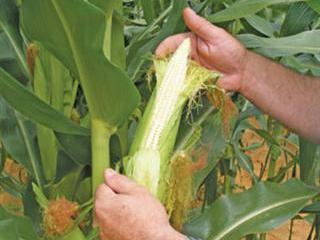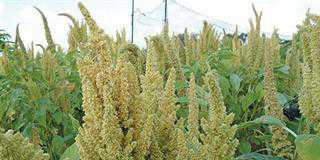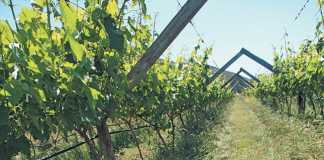
Farmers require highly adaptable maize to ensure high yields. Initially, this was achieved through cross-breeding different maize types, and this forms the basis of modern hybrid development. A plant is crossed when it’s fertilised with pollen from another plant, explains Dr Willie Venter who, along with fellow geneticist Chris van Zyl, specialises in breeding new maize hybrids.
Dr Venter says the development of a new maize hybrid is a long and costly process that can take up to 15 years, and involves a host of experts, such as entomologists and pathologists. The original open-pollinated South African varieties, such as Hickory King, were planted in the 1930s and 1940s. These were followed by double cross hybrids and the three cross varieties.
“The current hybrids are single crosses between two parents, resulting in remarkable uniformity and very good yield,” notes Dr Venter. Maize has separate male and female flowering parts. The ‘tassel’ at the apex of the plant is made up of the male flowers that produce pollen. The ‘ear’ emerging at the base of a leaf near the middle of the stalk is made up of the female flowers. A typical hybrid maize ear consists of several hundred kernels attached to the cob by surrounding modified leaves that protect the husk.
Each kernel starts as an ovule with a pistil. Hundreds of pistils grow out as the ‘silk’ at the tip of the ear. When the tassel is fully emerged, pollen shedding begins from the central spike of the tassel and than spreads out over the entire tassel. Pollen shedding usually starts two or three days before the silk emerges from the cob. The pollen grains are extremely small and very light, and are carried over long distances by the wind. Shedding stops when the tassel is too wet or too dry.

Chris van Zyl (left) and Dr Willie Venter.
The pistils are each covered by microscopic sticky hairs that catch and anchor the pollen grains, which germinate within minutes after landing. A pollen tube grows down the pistil to fertilise the ovule (the unfertilised potential kernel). This usually takes 12 to 18 hours. All the pistils emerge and are ready for pollination within three to five days. A tassel can produce up to 5 million pollen grains. Problems usually occur with poor synchronisation between silk emergence and pollen shed.
Pollination is a sensitive time for maize since unsuitable weather will result in a poor yield. Adequate soil moisture, a moderate temperature and a high relative humidity promote optimum pollination. Maize is a naturally cross-pollinated plant as the male and female flowering parts mature at slightly different times. Hybrid vigour is obtained when two lines from unrelated backgrounds are cross-pollinated.
Of the millions of pollinations made by maize breeders, a fraction of a percentage results in a commercial hybrid, stresses Dr Venter. “Hybrids can be created for a great many traits, such as pest resistance, ear size, uniformity and even the weather. In South Africa we need a relatively large variety of hybrids because of our different production environments,” he says.
Extreme production environments
The South African maize breeding industry must also cater for a wide range of production environments, from rainfed cultivation under as little as 500mm rain annually to crop rotation systems under irrigation. Then there’s the fact that maize is used for human consumption in South Africa. “The market demands white and yellow hybrids. Soil and climatic conditions vary across the production areas,” says Dr Venter. “No single hybrid can perform optimally under all these circumstances. “The industry requires different hybrids for different areas and applications.”
Drought tolerance and yield stability is particularly important in the drier areas such as the Free State and North West, for example. Around 26% of the world’s human population eat rice, 23% eat wheat and only 8% eat maize as a staple diet, notes Dr Venter. South Africa and other SADC countries, as well as Mexico and Guatemala, are some of the few places in the world where white maize is a human staple diet. Milling quality for white maize meal is therefore an added factor.
Specific requirements
Senior maize breeder Chris van Zyl explains the very specific requirements for respective hybrids. “The typical maize hybrid for the African or smallholder market has a single large ear per plant with white kernels. These hybrids must have a good ability to stay green, with grain that dries down slowly. They should also be resistant to diseases such as maize streak virus. In silage maize hybrids, the entire plant should be relatively digestible.
“These hybrids must also be resistant to root and stem lodging in case the farmer decides to let it dry down for grain production,” continues Chris. “Irrigation hybrids must thrive under high densities and produce high yields in a relatively short time. “Green mealie hybrids must produce big, well-filled ears of pure white grain. Slow conversion of sugars ensures a good shelf life.”

South African maize is produced under many different environments, from rainfed production at below 500mm of rain per year to maize produced under irrigation, with different soils types. This calls for a variety of seed hybrids.
Genetically tailored maize has been deliberately genetically modified (GM) for specific agronomical traits, explains Chris. These include resistance to herbicides (Roundup-Ready) and insects. The latter have been achieved by incorporating a gene that gives the maize resistance to Busseola fusca (maize stem borer) and Chilo partellus (chilo borer), says Chris. The first commercial varieties of GM maize became available in the US in 1996, while the first GM maize in South Africa was approved in 1998/1999.
The first Bt white maize was planted in 2001/2002, the first herbicide-resistant maize in 2003/2004 and the first stack-gene hybrids (Bt + herbicide tolerance) in 2007/2008, notes Chris. “A hybrid development process includes identifying appropriate parental stock to establish a new breeding population and many cycles of inbreeding and selection,” he explains. “It needs several seasons of hybrid testing in different locations. This is followed by the registration of the selected hybrids and the bulking up of parent lines and new hybrid seed.
“A new maize hybrid must go through a stringent process to prove that it is clearly distinct from all the hybrids already commercially available.” The industry is regulated in terms of the Plant Improvement Act of 1976. Seed earmarked for import and export markets must comply with the phytosanitary regulations set out by the department of agriculture. Chris and Dr Venter say their main challenge is to forecast what the seed maize requirements will be in 20 years’ time. “The main objective remains to breed seed that will add to long-term sustainability and profitability for the maize production industry in South Africa,” explains Dr Venter.
Contact Dr Willie Venter at [email protected] and Chris Van Zyl at [email protected].













